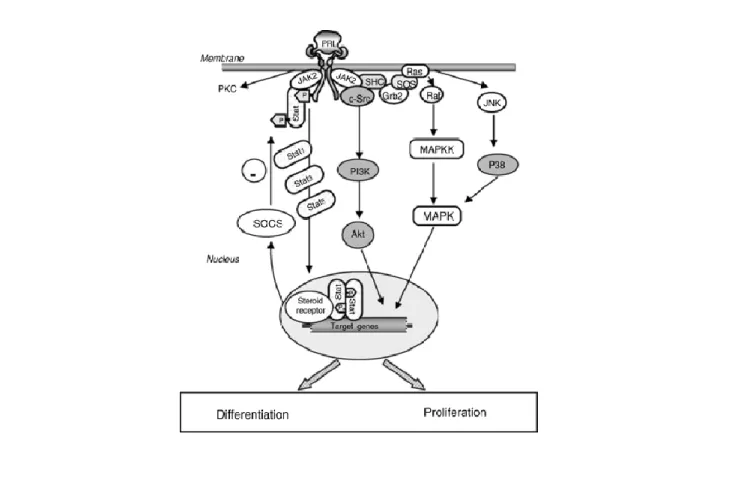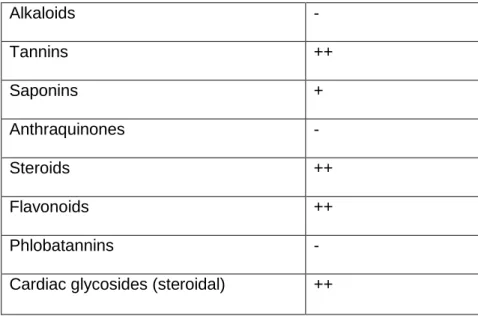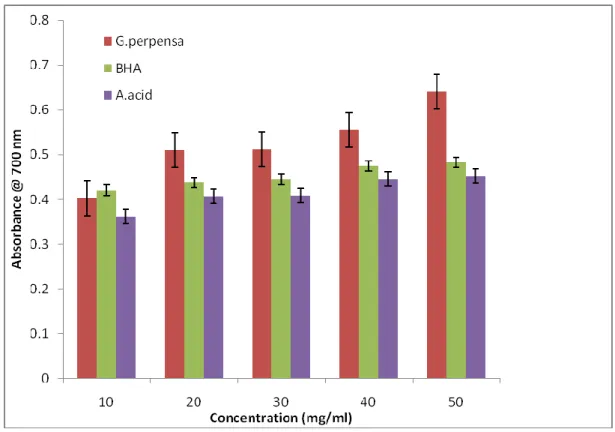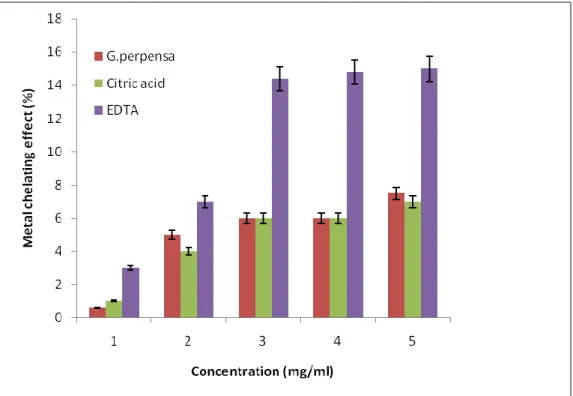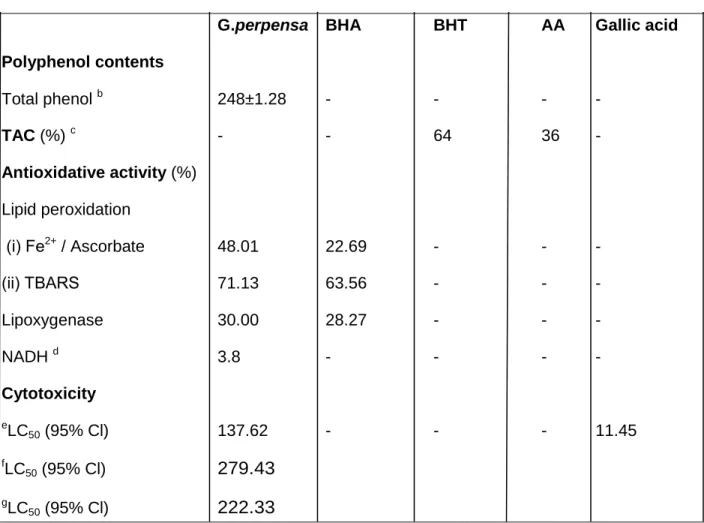The effect of an aqueous extract of the rhizome of the plant on milk production in rats was also investigated. G perpensa extract was found to stimulate uterine contractions; the highest amplitude was 5.06±08mm.
MILK PRODUCTION AND SECRETION
The functions of prolactin on the mammary gland involve growth and development of the mammary gland (mammogenesis), synthesis of milk (lactogenesis) and regulation of milk secretion (galactopoiesis). Proliferation and differentiation of secretory mammary epithelium is dependent on the presence of the prolactin receptor (PrlR) (Ormandy et al., 1997) and the downstream Jak2-Stat5 pathway (Liu et al., 1997).
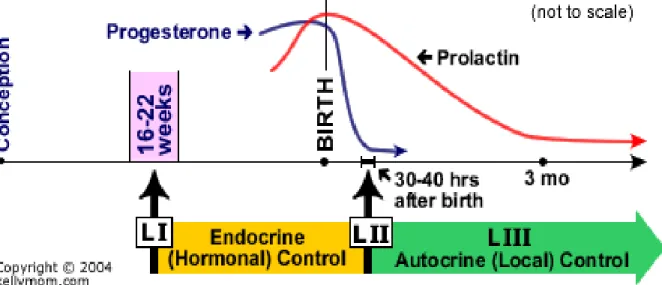
TRADITIONAL MEDICINE
SOME PLANTS THAT STIMULATE MILK PRODUCTION
- GUNNERA PERPENSA
Many herbs are used to stimulate milk production; most of them have a long history of traditional use, mainly to stimulate milk production in animals. Acacia nilotica ssp adansonii also stimulates milk production in lactating women by stimulating the synthesis and release of prolactin and promoting lobuloalveolar development (Lompo-Ouedraogo, et al. 2004).

ETHNOBOTANICAL SURVEY
FREE RADICALS AND ANTIOXIDANTS
Providing modern health care to rural people is still a far reaching goal, due to economic constraints (Grover et al., 2002). Therefore, it is necessary to make use of forms of medicine that mostly depend on the locally available plant material to treat various health disorders (Subhasree et al, 2009). The antioxidant activity of most plants is mostly due to phenolic components, such as flavonoids (Pietta, 1998), phenolic acids and phenolic diterpenes (Shahidi and Wanasundara, 1992).
SCOPE OF THIS WORK Aim
The harmful action of free radicals can result in the death of milk secretory cells and therefore reduce or stop milk production. The antioxidant activity of phenolic compounds is mainly due to their redox properties, which can play a significant role in the absorption and neutralization of free radicals, the quenching of single and triple oxygen, or the decomposition of peroxides (Osawa, 1994).
MATERIALS AND METHODS
Materials (see appendix A for details)
METHODOLOGY (see appendix B for details) .3 Plant collection and preparation
- Preparation of methanol and water extracts
- Phytochemical screening
ANTIOXIDANT ACTIVITY
- Free radical scavenging activity
- Superoxide anion (O - 2 ) scavenging activity
- Hydroxyl radical ( - OH) scavenging activity
- NO - scavenging activity
- Reducing power
- Chelating Activity on Fe 2+
- Effect on Xanthine oxidase activity
- Effect of extract on DNA sugar damage
- Effect of extract on lipid peroxidation
- Lipid peroxidation induced by Fe 2+ / Ascorbate
- Lipid peroxidation in the rat brain homogenate
- Effect of extract on Lipoxygenase (lipoxidase) activity
- Determination of malondialdehyde (MDA)—TBARS
- Effect of extract on Acetylcholine esterase activity
- Total phenolic content
- NADH Content
- Determination of total antioxidant capacity
- Calculation of percentage inhibitory effect of G. perpensa extract
The Fe2+ chelating effect of the extract was measured according to the method of Decker and Welch (1990). After cooling to room temperature, the absorbance of the solution was measured at 695 nm against a blank.
CYTOTOXICITY ASSAY
- Brine Shrimp Lethality Screening
- MTT cell proliferation assay
The G perpensa extract (0.3 ml) was combined with 3 ml reagent solution (0.6M sulfuric acid, 28 mM sodium phosphate and 4 mM ammonium molybdate). The inhibitory concentration providing 50 % inhibition (IC50) was calculated from the graph of percentage inhibition against G. The percentage mortality at each concentration and control was calculated using the Abbotts formula (Abbott, 1925).
Human embryonic kidney cells (HEK293) and human hepatocellular carcinoma cells (HEPG2) were all grown to confluency in 25 cm flasks. The medium was then removed and replaced with complete medium (MEM + Glutmax + antibiotics + 10% fetal bovine serum).
ANIMAL EXPERIMENTS
- Lactogenic activity
- Effect of oral treatment with extract on milk production
- Uterine contraction studies
- Blood analysis
The mothers were given the extract and the drug daily for a period of six days, from day 4 to day 9 of lactation. All groups received the extract and drug for six days from day 4 to day 9 of lactation (fig 3.1) on day 10 the rats were sacrificed. The abdominal muscles were opened and the two uterine horns of each rat were exposed to avoid stretching of uterine smooth muscles.
The bottom wire was attached to a hook connected to an aeration pipe in the organ bath, and the top wire was attached to an isotonic transducer connected to a strain gauge coupling located on the oscillograph. Blood was drawn from the heart (by cardiac puncture) and analyzed by Lancet laboratories (Richards Bay) using standard pathological procedures to measure prolactin, progesterone, insulin, growth hormone, cortisol, total bilirubin, conjugated bilirubin, albumin, total protein, urea, creatinine, alanine aminotransferase (ALT), aspartate aminotransferase (AST) and alkaline phosphatase (ALP).
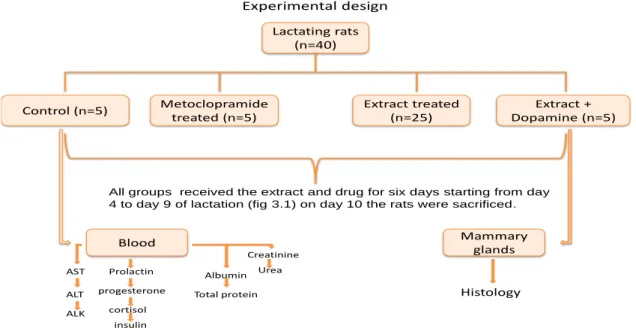
Histology of mammary glands
STATISTICAL ANALYSES
The methanol extracts were screened for antioxidant activity and the aqueous extract was screened for lactogenic activity.
Percentage yield
Phytochemical screening
ANTIOXIDANT ACTIVITY
- Free Radical scavenging activity
- Reducing power
- Chelating activity
- Other oxidative system and cytotoxicity
The results show that the reducing power of the extract is dose-dependent and with clearly better performance than ascorbic acid and BHA. The chelating activity of the extract for iron ions was tested by inhibiting the formation of red colored ferrozine and iron complex. At a concentration of 5 mg/l, the extract and citric acid chelated 7.51 and 7.42% of ferrous ions, respectively, while EDTA showed a moderate chelating activity of 14.81 ferrous ions.
The extracts significantly inhibited hydrogen peroxide-induced lipid peroxidation in the rat brain, and also inhibited lipoxygenase activity, and the AA/Fe2+. The cytotoxic activity against brine shrimp, and two human cell lines, HEH293 and HEPG2 shows that the degree of lethality was directly proportional to the different concentrations of the extract.
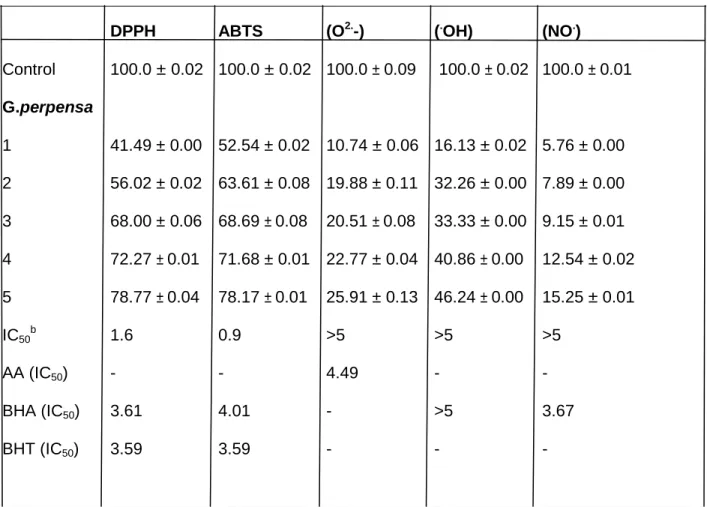
ANIMAL EXPERIMENTS
- Milk production
- Blood parameters
- Uterus contractility
Milk production data (Fig. 4.5) at 18 and 23 hours after gavage indicated that milk yield was significantly increased in the highest concentration group (1600 mg.kg-1) receiving the extract. Progesterone levels increased by 28.4% in the metoclopramide-treated group and by 16% in the extract/dopamine group compared to controls. AST was reduced in the group treated with 100 mg.kg-1 extract (p<0.05) and extract/dopamine group compared to control.
The aqueous extract of G.perpensa stimulated the development of the lobulo-alveolar system and its activity was found to be effective at high concentrations (1600 mg.kg-1). The mammary gland of a lactating rat given metoclopramide 5 mg.kg-1 shows little alveolar development and an abundance of fat cells.
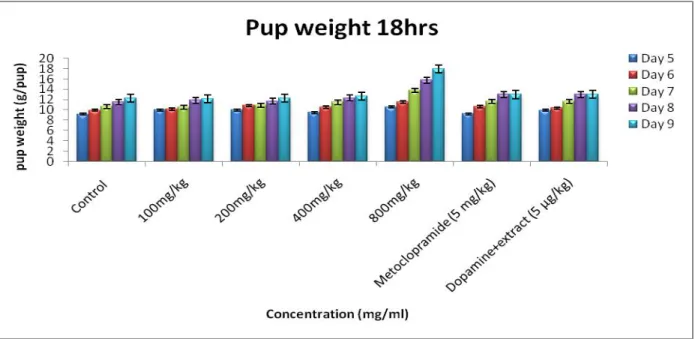
Effect of extract on Acetylcholinesterase activity
Milk is the food of the infant (infant) – the mother's investment in the growth and maturity of her offspring. It is produced by the mammary glands of a nursing mother for the baby. Mammary glands can be induced biochemically by an abnormal level of expression of circulating hormones (Gudjonsson, et al 2002) or by a mechanical change in the tension of the mammary stroma (Provenzano, et al 2008).
Breastfeeding the baby stimulates the release of the hormone oxytocin, which also causes myoepithelial cells to contract. In this way, the combined control of the extracellular matrix and systemic hormones can reciprocally increase milk secretion to provide sufficient nutrients to the infant (Zarzynska and Motyl, 2008).
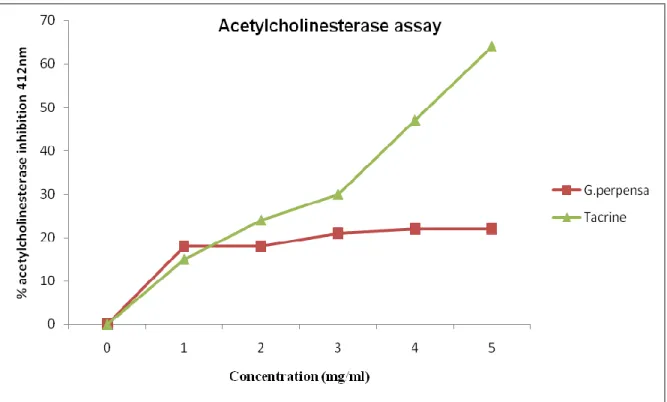
Antioxidant activity of G perpensa
In addition, reducing properties are associated with the presence of reductants, which act as antioxidants by breaking radical chains by donating a hydrogen atom (Gordon, 1990; Pin-Der-Duh, 1998). In addition, reductones have also been reported to prevent peroxide formation by reacting with some peroxide precursors (Rathee et al, 2007). Transition metals can initiate lipid peroxidation by generating hydroxyl radicals via the Fenton reaction and accelerate lipid peroxidation via lipid hydroperoxides to peroxyl and alkyl radicals (Zhao et al., 2006).
Plant constituents that have been reported to be free radical scavengers and anti-hyperoxidative include polyphenol (Maisuthisakul et al., 2007; Adedapo et al., 2009), reduced glutathione (Bhatia and Jain, 2004), and NADH (Stern et al. ., 2002). NADH therapy is known to have beneficial effects in patients with chronic fatigue syndrome (Santaella et al, 2004).
Milk production
It is also noted that G.perpensa does not significantly affect progesterone and cortisol levels. This decrease can be attributed to a decrease in globulin (especially α1 and γ fractions) causing an increase in the albumin/globulin ratio rather than a change in albumin level (El-Sherif and Assad, 2001). ALT and AST levels in this study showed a tendency to rise with increasing plant extract concentration.
Blood test results seem to indicate that G.perpensa extract stimulates milk production in some non-hormonal way. G.perpensa has been found to increase milk production by inducing alveolar development and contraction of myoepithelial cells, resulting in milk ejection.
Cytotoxic activity
It is evident that the mechanism of action of G.perpensa, which causes muscle contraction, is through the inhibition of acetylcholinesterase activity. To what extent aqueous extracts of G. perpensa would affect milk production/milk flow would be impossible to judge based on histological findings alone, but since physiological milk yield was determined, histological results demonstrate that G. perpensa stimulates alveolar development. Although the exact mechanism of its effectiveness in promoting labor and facilitating placental expulsion or relieving menstrual pain is still unknown, the potential antioxidant capacity and weak toxic effect of G.perpensa were identified in this study.
It is clear that G.perpensa contains compounds that can enhance the effect of natural dietary antioxidants. The relatively high total phenolic and NADH content and the significant total antioxidant capacity, expressed as the percentage of BHT, could contribute to the antioxidant properties of G.perpensa.
SUGGESTION FOR FUTURE STUDIES
The role of growth hormone, prolactin and insulin-like growth factors in the regulation of rat mammary gland and adipose tissue metabolism during lactation. 1992).Investigation of the mechanism of action of growth hormone in promoting lactation in rats. Effect of aqueous extract of Acacia nilotica ssp adansonii on milk production and prolactin release in rats.
Control of mammary epithelial differentiation: basement membrane induces tissue-specific gene expression in the absence of intercellular interaction and morphological polarity. Effects of short-term administration of glucagon on gluconeogenic enzymes in midge liver, J Dairy Sci.
Appendix A Reagent Details
- Dragendroff’s reagent
- Mayer’s reagent
- Sulphanilic acid reagent
- De Jalons physiological solution preparation
- Glutathione preparation
- Preparation of Artificial Sea Water
- Phosphate buffer (pH 7.4)
- Tris-buffer (pH 7.0)
- Sodium borate buffer (pH 8)
- Borate buffer (0.2M, pH 9.0)
- Linoleic acid (substrate) preparation
- Formalin
We measured the pH of natural seawater and found it to be 7.8 at a temperature of 28-30 oC. 40 ml of 0.2 M potassium hydroxide was prepared and mixed with 50 ml of 0.2 M potassium dihydrogen phosphate. 50 ml of glacial acetic acid and 50 ml of distilled water were mixed and 1 g of TBA was added to the solution, and the solution was made up to 100 ml with distilled water.
The mixture was gently mixed into an emulsion, with low stirring water was added to 50 ml. 50 ml of 40 percent formalin was added and the resulting mixture was made up to 400 ml with distilled water.
APPENDIX B
Details of Methodology
- Phytochemical screening
- Antioxidant activity
- Assay of superoxide radical (O - 2 ) scavenging activity: The assay was based on the capacity of the extracts to inhibit the photochemical reduction of nitroblue
- Determination of total antioxidant capacity: 0.3 ml extract (0-5 mg/100 ml) was combined with 3 ml of reagent solution (0.6 M sulfuric acid, 28 mM sodium phosphate
- Lipid peroxidation induced by Fe2+ / Ascorbate (AA/Fe 2+ ): The liver was obtained from the rat and it was quickly weighed and perfuse with phosphate buffer
- NADH: A modified method for determining NADH by Stern et al (2002) was used to determine the concentration of NADH in the plant extract. Phosphate buffer (containing
- MTT cell proliferation assay
- In vivo study
A pink color in the ammonia layer was taken as evidence for the presence of combined anthraquinone. a) Lead acetate test; 1 ml of extract was mixed with 10 % lead acetate. Reddish-brown color (or precipitate) was an indication of the presence of flavonoids. b) Ferric chloride test; 1 ml of extract was mixed with 10 % ferric chloride. Color change from violet to blue or green indicates the presence of steroidal core ie. the aglycone portion of the cardiac glycosides.
Red-brown color at the interface indicated the presence of steroidal core, i.e. the aglycone portion of the cardiac glycosides. The mixture was heated in a boiling water bath for 30 minutes; allowed to cool then 2 ml of n-butanol was added.
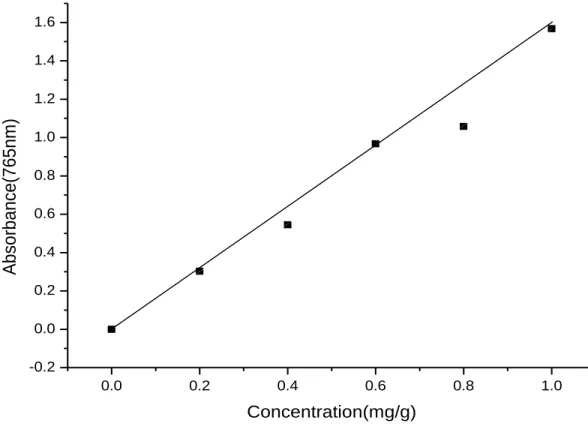
APPENDIX C
Appendix D
The total antioxidant capacity of the plant was 36% relative to ascorbic acid and 64% relative to butylated hydroxytoluene (BHT). Plant material from Gunnera perpensa was collected from the KwaDlangezwa area of KwaZulu-Natal and identified at the Department of Botany, University of Zululand, KwaDlangezwa. The authors are grateful to NRF, MRC and the University of Zululand Research Committee for their funding.
Buwa LV, van Staden J 2006; Antibacterial and antifungal activity of traditional medicinal plants used against sexually transmitted diseases in South Africa, Journal of Ethnopharmacology, Volume 103, Issue 1, Pages 139-142. Rama, 1997; Preliminary Screening of Plants Used in South Africa as Traditional Herbal Medicines During Pregnancy and Childbirth, Journal of Ethnopharmacology, Volume 55, Issue 3, Pages 185-191.
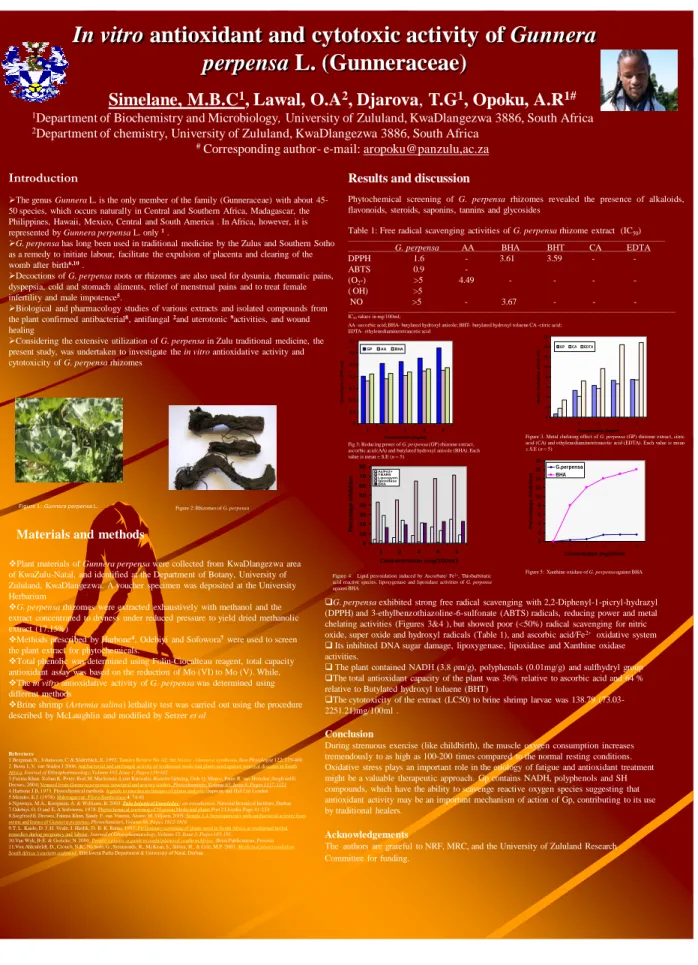
APPENDIX E
